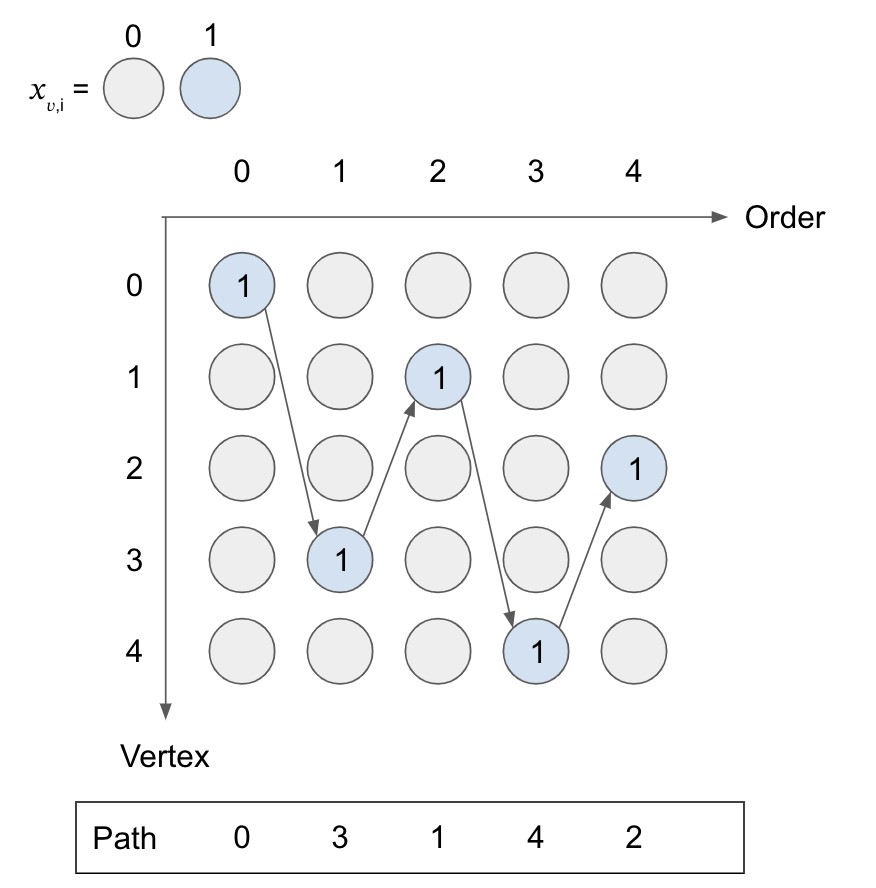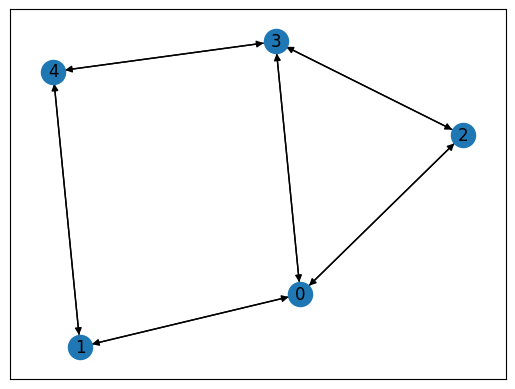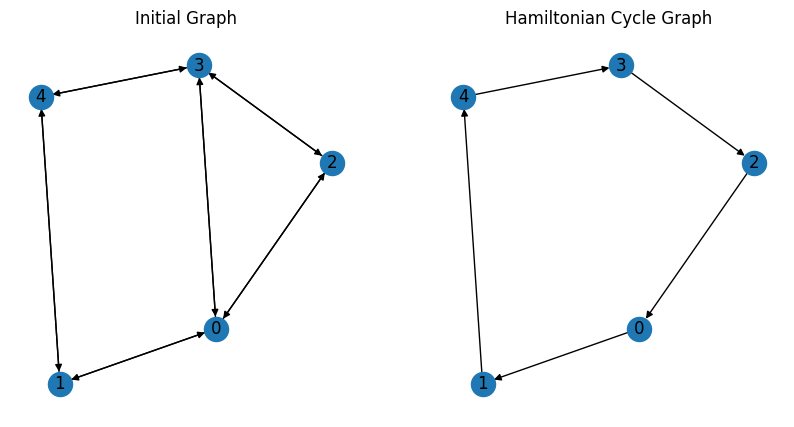Hamiltonian Cycles and Paths
Here we show how to solve the Hamiltonian cycles and paths problem using JijZept and JijModeling. This problem is also mentioned in 7.1. Hamiltonian Cycles and Paths on Lucas, 2014, "Ising formulations of many NP problems".
What are Hamiltonian Cycles and Paths?
The Hamiltonian path problem is defined as follows. Starting from a vertex in given graph, make a travel along the edges so that the traveler visits every vertex exactly once. The Hamiltonian cycles problem requires in addition that the traveler should return to the starting vertex (i.e. the traveler visits the starting point twice.). Note that the graph can either be directed or undirected.
Mathematical model
Without loss of generality, we label the vertices by and assume the edges are directed; i.e. and denote different edges from each other. For the given graph , we consider that a vertex is visited in the -th step if a binary variable is , and vice versa.
Constraint 1: every vertex in the graph must be visited exactly once
This constraint can be formulated in a quite simple way:
Constraint 2: the path must be connected
This means that there must be only one -th vertex in the cycle for each .
The following figure illustrates a valid path, and you can count the number of variables that take for each row and column to confirm the above two conditions held.

Constraint 3: an edge must be in if it is used in the path
If an edge is used in the path, both and take , so that this constraint is formulated as below.
Note that this constraint should be considered for the Hamiltonian cycles problem. As for the Hamiltonian paths problem instead, one relaxes the condition a bit by changing to ; this means that we do not have to care about the edge between the first and the last vertices.
Modeling by JijModeling
We show how to implement above equations using JijModeling. We first define the variables in the mathematical model described above.
import jijmodeling as jm
# define variables
V = jm.Placeholder('V')
barE = jm.Placeholder('barE', ndim=2)
num_barE = barE.shape[0]
i = jm.Element('i', V)
v = jm.Element('v', V)
x = jm.BinaryVar('x', shape=(V, V))
f = jm.Element('f', num_barE)
The constraints are written as:
problem = jm.Problem("Hamiltonian Cycles")
problem += jm.Constraint('one-vertex', x[v, :].sum()==1, forall=v)
problem += jm.Constraint('one-path', x[:, i].sum()==1, forall=i)
problem += jm.Constraint('one-edge', jm.sum([f,i], x[barE[f][0],i]*x[barE[f][1],(i+1)%V])==0)
On Jupyter Notebook, one can check the problem statement in a human-readable way by hitting
problem
Prepare an instance
We prepare a graph using Networkx.
import networkx as nx
# set empty graph
inst_G = nx.DiGraph()
# add edges
for u,v in [[0,1], [0,2], [0,3], [1,4], [2,3], [3,4]]:
inst_G.add_edge(u,v)
inst_G.add_edge(v,u)
inst_barE = []
for u,v in list(nx.complement(inst_G).edges):
inst_barE.append([u,v])
# get the number of vertex
inst_V = list(inst_G.nodes)
num_V = len(inst_V)
instance_data = {'V': num_V, 'barE': inst_barE}
This graph is shown below.
import matplotlib.pyplot as plt
# Compute the layout
pos = nx.spring_layout(inst_G)
nx.draw_networkx(inst_G, pos=pos, with_labels=True)
plt.show()

Solve by JijZept's SA
We solve this problem using JijSASampler.
import jijzept as jz
# set sampler
sampler = jz.JijSASampler(config="../../../config.toml")
# solve problem
response = sampler.sample_model(problem, instance_data, multipliers={"one-vertex": 0.5, "one-path": 0.5, "one-edge": 0.5}, search=True, num_reads=100)
Visualize the solution
The result can be seen as below.
import matplotlib.pyplot as plt
# get sampleset
sampleset = response.get_sampleset()
# extract feasible samples
feasible_samples = sampleset.feasibles()
if len(feasible_samples) == 0:
print("No feasible sample found ...")
else:
# get a feasible solution
feasible_solution = feasible_samples[0].var_values["x"].values
# get the indices of x == 1
x_indices = feasible_solution.keys()
# sort by time step
path = [index for index, _ in sorted(x_indices, key=lambda x: x[1])]
# append start point
path.append(path[0])
# make the directed graph from paths
inst_DG = nx.DiGraph()
inst_DG.add_edges_from([(path[i], path[i+1]) for i in range(len(path)-1)])
# create the figure with two subplots
fig, (ax1, ax2) = plt.subplots(1, 2, figsize=(10, 5))
# draw the initial graph
nx.draw_networkx(inst_G, pos, with_labels=True, ax=ax1)
ax1.set_title('Initial Graph')
plt.axis('off')
ax1.set_frame_on(False) # Remove the frame from the first subplot
# draw the directed graph
nx.draw_networkx_nodes(inst_DG, pos)
nx.draw_networkx_edges(inst_DG, pos, arrows=True)
nx.draw_networkx_labels(inst_DG, pos)
plt.axis('off')
ax2.set_title('Hamiltonian Cycle Graph')
# show the graphs
plt.show()

As expected, we obtain a Hamiltonian cycle.